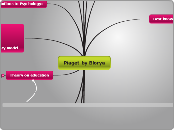Piaget-by Blorya
stages of development
based on the book: Conversations with Jean Piaget (conversation # 4)
stages of development have to do with the conscious as well.
every child is ready to grasp certain ideas when his brain is ready for that age stage of development. when the conscious is mature, the brain will be able to attain the level of the conscious. in short, the conscious has its level of understanding as well based on the stage of development that the child is at.
every age has its stage of development
it's important for a teacher to be aware of those stages of development and make sure that the material taught in class is suitabale for that age group.
סכמות, הטמעה, התאמה ואיזון
based on the book: Conversations with Jean Piaget (conversation # 5)
הטמעה והתאמה הם תהליכים, שאנו מתייחסים באמצעותם אל הגירויים בסביבתנו.
הטמעה (assimilation)- בתהליך ההטמעה הגירויים החדשים נקלטים בתוך הגירויים הישנים. במילים אחרות: אנו תופסים את הגירויים ומתייחסים אליהם בהתאם לידע שיש לנו על הגירויים. כך גם ילדים מטמיעים (מכניסים) גירויים לא מוכרים בסביבה אל תוך הסכמות שלהם ומתנהגים אל הגירויים האלה בהתאם למבנים המחשבתיים שלהם (בתוך הסכמות שקיימות אצלם).
התאמה (accomodation) - במקרים רבים לצורך ההתקדמות אל האיזון עלינו לשנות את הסכמות (את המבנים המחשבתיים), כדי שיתאימו לסביבה. לשם כך אנו מבצעים התאמה.
התאמה היא שינוי הסכמות והתאמתן לידע שיש לנו ואף לניסיון שרכשנו. שינוי זה מרחיב את מאגר הידע שלנו ומגדיל אותו.
סכמה - פיאז'ה טוען כי הידע שלנו על העולם מאורגן במוח במבנים קוגניטיביים, שנקראים סכמות. סכמה היא יחידה בסיסית - חזותית, התנהגותית, אקוסטית או סמנטית - של ידע העולם. ידע זה מכתיב לנו את דרך ההסתכלות על העולם ומנחה אותנו כיצד להגיב לגירוי מסוים. באמצעות הסכמה אנו מעבדים את המידע הנקלט, בצורות שונות של עיבוד מידע: תפיסה, זכירה, למידה, פירוש וכדומה.
עפ"י פיאז'ה סכמות הם אינם מבנים נתונים וקבועים מראש אלה נבנים כל הזמן בפעולת גומלין בינינו לבין הסביבה (ע"מ 54 מתוך "הלמידה האנושית", שיחות עם פיאז'ה).
איזון - העיקרון הכללי המרכזי בהתפתחות השכלית (הקוגניטיבית) הוא האיזון (שיווי המשקל), וההתפתחות שלנו היא התקדמות לקראת איזון
conscious
A metaphor to the concept - conscious
Animal's conscious is limited and is not as developed as the human beings'. Animals possibly can't integrate and infuse mew and older material.
based on the book: Conversations with Jean Piaget (conversation # 3)
The conscious integrates and infuses the older material with the new material and operates in contrast
conscious also connects between the subject (Me) to the object (that which i wish to work with)
conscious is the sum of cognitive structure that includes schemes, memory and the brain
Theory on education
based on the book: Conversations with Jean Piaget
can metaphysics be considered as "conscious"?
since it be measures i.e. prooved, it is not considered as conscious.
what is the conscious?
not every idea that is accepted by a group of respectful people can be describes as "conscious" but rather any idea that can be given over and criticisized.
Theory model
Contributions to Psychology:
He created the International Center for Genetic Epistemology in 1955 and served as director until his death.
provided support for the idea that children think differently than adults
Death
•Died September 16, 1980
Birth
Jean Piaget was born in Switzerland in 1896
Best known for
Piaget's theory described stages that children pass through in the development of intelligence and formal thought processes.
(1)the sensorimotor stage, (2)the preoperational stage, (3)the concrete operational stage, and (4) the formal operation stage
studied the intellectual development of his own three children
his research on children's cognitive development
Education
Piaget spent fifty years studying children.
received his doctoral degree at age 22
Family life
had 2 daughters and one son
In 1923, Piaget married Valentine Chatenay, and their first daughter

